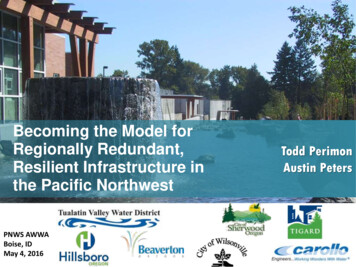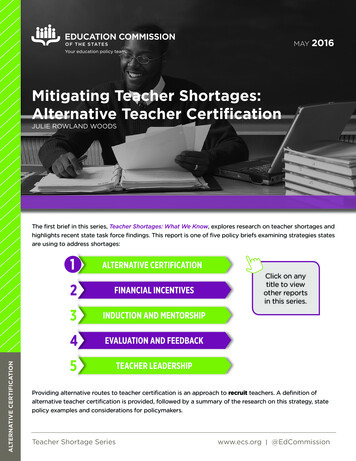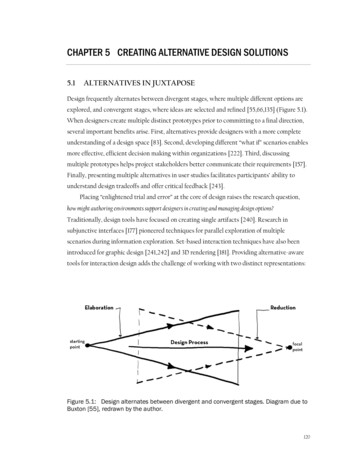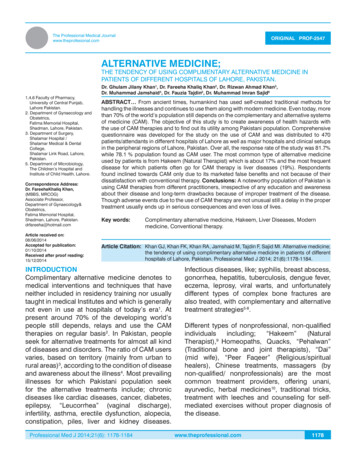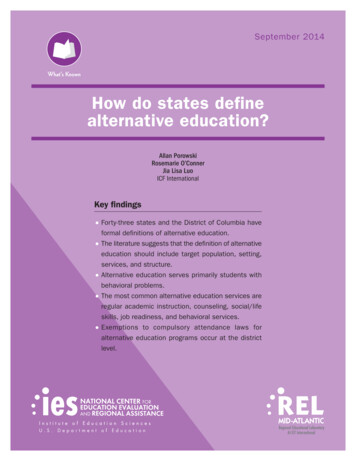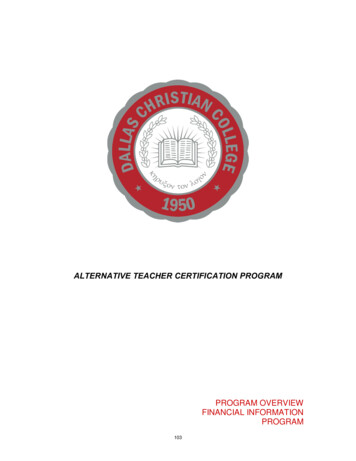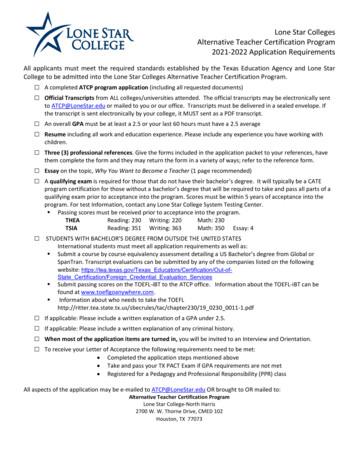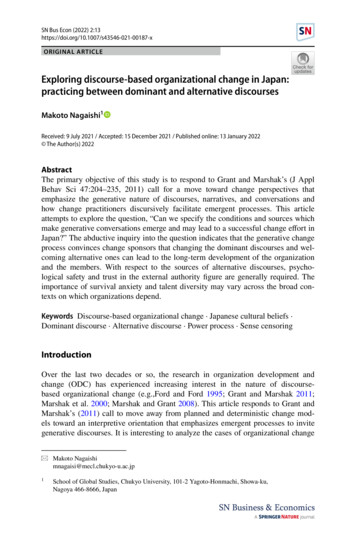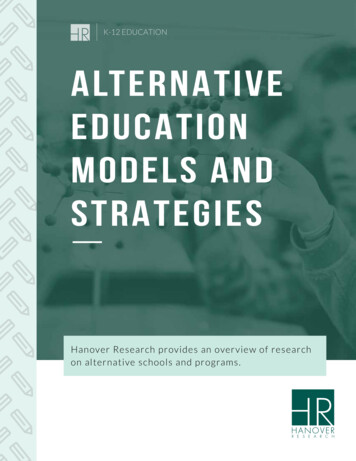
Transcription
K-12 EDUCATIONALTERNATIVEEDUCATIONMODELS ANDSTRATEGIESHanover Research provides an overview of researchon alternative schools and programs.
INTRODUCTIONINTRODUCTIONWhile traditional K-12 education meets the needs of most students, 64% ofschool districts across the nation offer at least one alternative school or programdesigned to “address the needs of students that typically cannot be met in regularschools.” Alternative education encompasses any non-traditional educationalactivity, and most commonly serves middle or high school students. Alternativeeducation delivery can occur within traditional schools or at separate sites.The three most common alternative education models are: Alternative schools, typically housed in a separate facility, requiringstudents to leave their regular school. Alternative programs, typically housed within regular schools. Targeted, school-based support strategies, i.e. academic, behavioral, andhealth services provided in the school setting.Alternative education can serve many types of students to meet a range of goals,such as helping students earn academic credits, providing career preparation andcredentials, or assisting students in transitioning out of a detention or treatmentprogram and back into traditional schools. The services provided by an alternativeschool or program depend on the program’s purpose and the specific populationserved, but may include: regular academic instruction, counseling, behavioralservices, social skills and support services, and career education.This research brief describes the types of alternative education servicesthat school districts may provide, and summarizes the research evidencesupporting each type of alternative education model.ACKNOWLEDGEMENTSContributions to this publication were made by the following Hanoverians:Chief Content Officer: Anil PrahladProject Leads: Leila Nuland, Meagan GregoryContributors: Laura Baker, Kristen Campbell, Rachel Dotter, Michael LeshnerEditorial Team: Amanda Lockhart, Erin Morris, Jamal Russell-Black, Jordan WellsDesigned by: Johanna Mora, Louisa Smith 2018 Hanover ResearchK12WP03182
TA B L E O F C O N T E N T STA B L E O F C O N T E N T S03INTRODUCTION04I. ALTERNATIVE SCHOOLS (SEPARATE SITE)0709 2018 Hanover ResearchK12WP031804CHARTER SCHOOLS05MAGNET SCHOOLS06CAREER AND TECHNICAL EDUCATION PROGRAMS06DROPOUT PREVENTION AND CREDIT RECOVERY SCHOOLSII. ALTERNATIVE PROGRAMS (SAME SITE)07SCHOOL-WITHIN-A-SCHOOL PROGRAMS08RESOURCE PROGRAMSIII. DIAGNOSTIC: CHECKLIST FOREVALUATING ALTERNATIVE EDUCATION MODELS3
I . A LT E R N A T I V E S C H O O L S ( S E PA R A T E S I T E )I. ALTERNATIVE SCHOOLS (SEPARATE SITE)Alternative schools encompass a variety of alternative education options including charter schools, magnetschools, and career and technical education programs.TYPES OF ALTERNATIVE SCHOOLSMODELDESCRIPTIONSTUDENTS SERVEDCharterSchoolsCharter schools are privatelymanaged, taxpayer-fundedschools that have increasedflexibility and autonomy. A variety ofstudents acrossgrade levelsMixed Findings. Researchsuggests that locally-andstate-managed charterschools with stronginstructional supportscan be effective.MagnetSchoolsA magnet school or programtypically has an academic orsocial focus on a theme (e.g.,STEM, performing arts) andintends to attract students ofdifferent racial, ethnic, and/orsocioeconomic backgrounds. A variety ofstudents acrossgrade levelsMixed Findings. Researchsuggests that magnetschools may improvebehavioral and academicoutcomes.Career andTechnicalEducation (CTE)ProgramsCTE programs blend rigorousacademics with careerpreparation to preparestudents for college and/orcareers. Typically highschool, andoccasionallymiddle schoolstudentsPositive Findings. Researchsuggests that participationin a CTE program improvesgraduation rates for at-riskstudents.DropoutPrevention andCredit RecoverySchoolsDropout prevention andcredit recovery schools (oftenreferred to as “alternativeschools”) provide studentsat-risk of not graduating withan alternative pathway. High schoolstudents atrisk of notgraduatingPositive Findings. Researchsuggests that alternativehigh schools can improvegraduation rates for atrisk students but thatprogram effectivenessranges by program type andimplementation. 2018 Hanover ResearchK12WP0318 Minority and/orlow-SESstudents Students withacademic,behavioral, and/or emotionalneedsRESEARCH SUPPORT4
I . A LT E R N A T I V E S C H O O L S ( S E PA R A T E S I T E )CHARTER SCHOOLSSPOTLIGHT:LOWELL MIDDLESEX ACADEMYCHARTER SCHOOLAlthough part of the publics school system,charter schools typically have their ownappointed school board. An individual ororganization hoping to open a charter schoolLower Middlesex Academy Charter Schoolmust apply to an “authorizer,” which may be a(LMACS) in Lowell, MA primarily serves students atlocal school district, state education agency,risk of dropping out or who have left school priora charter board, or a non-profit organization.to graduation. LMACS offers a general curriculum,To enroll in a charter school, students typicallycareer preparation opportunities, English learnerapply for admission, and schools may hold acourses, special education instruction, and accesslottery when the number of applicants exceedsto dual enrollment courses at the local communitythe number of available seats. Evidence iscollege. Students are grouped by “phases”—rathermixed as to the effect of charter schools onthan grade level—based on how many credits theystudent achievement in comparison to that ofhave earned toward high school graduation. Thetraditional schools. The National Educationcore academic curriculum is supplemented by dailyAssociation notes that studies “show very smalladvising; courses in life skills, ethics, and health;differences [between the two models], someand a requirement that students complete a 50favoring traditional district schools and somehour internship. The Boston Globe and the Renniefavoring charter schools.” The University ofCenter for Education Research & Policy haveWisconsin Population Health Institute similarlyrecognized LMACS for its “track record of success”notes that there is mixed evidence regarding theand “powerful learning partnerships” that promoteeffectiveness of charter schools—“when effectscollege and career readiness.are averaged charter schools demonstratesimilar outcomes to traditional schools overall.”However, charter school management may be associated with student outcomes, with some studies showingthat charter schools authorized by districts, states, and regional education agencies outperform thoseauthorized by non-profits.MAGNET SCHOOLSA magnet school or program is “designed to attract students of different racial/ethnic backgrounds for thepurpose of reducing, preventing, or eliminating racial isolation; and/or to provide an academic or socialfocus on a particular theme (e.g., science/math, performing arts, gifted/talented, or foreign language).” Asingle district or group of districts may operate a magnet school. Similar to the charter school system,students may apply to attend magnet schools, which are part of the public education system.Research suggests that magnet schools may improve behavioral outcomes; however, findings are mixedas to their effects on student achievement. Some studies have found an association between magnetschool attendance and positive effects on student achievement, student body diversity, graduation rates,and students’ attitudes and behavior. However, o t h e r s t u d i e s f i n d t h a t , w h i l e m a g n e t s c h o o l sm ay i m p r o v e b e h av i o ra l o u t c o m e s , t h e y h av e n o e f f e c t o n a c h i e v e m e n t . 2018 Hanover ResearchK12WP03185
I . A LT E R N A T I V E S C H O O L S ( S E PA R A T E S I T E )SPOTLIGHT: LINCOLN MAGNET SCHOOLLincoln Magnet School (LMS) in Springfield, IL is a technology magnet schoolthat uses technology to enrich and empower students in Grades 6 to 8. All districtstudents are eligible to apply to LMS through a lottery system. The school offerslearning based on the International Society for Technology in Education’s learningstandards; career education and “real-world” learning opportunities; acceleratedmath courses; and extracurricular opportunities such as an after-school enrichment program emphasizing“logic, mathematical thinking, and experimental scientific thinking.” The school was recognized as a “HighPerforming National Blue Ribbon School in 2011 and as a “Apple Distinguished School” from 2009 to 2014.CAREER AND TECHNICAL EDUCATION PROGRAMSCareer and technical education (CTE) programscombine academics and career readiness toprepare students to be college and career ready.Students can receive CTE instruction either withina comprehensive high school or at a designatedCTE center or technical school.Research indicates that participation in CTEincreases graduation rates. A recent review ofCTE studies found “strong evidence” that CTEparticipation improves graduation rates, and someevidence that CTE participation improves postsecondary, employment, and earnings outcomes.On average, CTE participation increases graduationrates for at-risk students by 16 percent, with theeffects stronger for male students and studentsfrom low-income families.DROPOUT PREVENTIONAND CREDITRECOVERY SCHOOLSSchools that focus on dropout prevention—oftenreferred collectively to as “alternative schools” andconsidered separately from charter, magnet, and CTE 2018 Hanover ResearchK12WP0318SPOTLIGHT:MONTACHUSETT REGIONALVOCATIONAL TECHNICAL SCHOOLMontachusett RegionalVocational Technical School,located in Fitchburg, MA,offers 21 rigorous programsthat combine academic andvocational education to prepare studentsfor both college and careers. Programsfocus on career pathways in fieldssuch as information technology, healthoccupations, masonry, and engineering.The Cooperative Education programallows Grade 11 students to combinetheir classroom work with applied workexperience through part-time internshipswith local businesses. Further, graduationrequirements ensure that students will beeligible for enrollment in higher educationinstitutions, and the school’s students havehigher four-year graduation rates than thestate average.6
I I . A LT E R N A T I V E P R O G R A M S ( S A M E S I T E )SPOTLIGHT: READY PROGRAMThe Regional Alternative for Development Youth (READY) Program provides alternativeschooling for students found guilty of misconduct. The program serves Grades 6 to 12students in districts within two counties in Illinois who have been suspended or expelled,have a criminal history, or who were involved in misconduct. Students are relocated from theirhome schools to the READY program for a minimum of 18 weeks. Components of the program include servicebased projects, social skills training, job training, internship opportunities, and mental health support services.Further, the student-teacher ratio is 10:1, much lower than the state average of 19:1.schools and centers—vary widely in purpose, student subgroups served, curriculum, and setting. While somealternative schools may aim to prepare students to return to their regular schools, many provide a permanentalternative route to graduation. Alternative school models that support students who are at-risk of droppingout include residential school, summer school, second-chance school, and early college high schools.Research indicates that alternative high schools for at-risk students can increase graduation rates.On average, alternative schools result in a 15.5 percent increase in graduation rates for at-risk students.However, the design and implementation of alternative high schools for at-risk students can vary widely,which impacts their effectiveness. Poor attendance rates and inadequate staffing and high turnover, forexample, may negatively affect student outcomes.II. ALTERNATIVE PROGRAMS (SAME SITE)Alternative programs are alternative education offerings housed within regular schools. Types ofalternative program models include school-within-a-school and resource rooms or resource teachers.TYPES OF ALTERNATIVE PROGRAMSMODELDESCRIPTION High school studentsat-risk of not graduating SchoolWithin-ASchool ProgramsA school-within-aschool program is a“mini-school” within atraditional school thatserves a particulargroup of students whotake classes together.Students with emotional orbehavioral issues Students who strugglewith anxiety or substanceabuse issues Students across gradelevels with a variety ofacademic, behavioral, andsocial needsResourceProgramsStudents may receivealternative educationservices throughpull-out instructionprovided in aresource room. 2018 Hanover ResearchK12WP0318STUDENTS SERVEDRESEARCH SUPPORTLimited positive findings.Some research suggeststhat career academies, acommon type ofschool-within-a-schoolprogram, may improvegraduation rates and postsecondary outcomes.Limited positive findings.Research suggests thatsmall-group and individualinterventions providedin separate classes caneffectively supporthigher-risk students’behavioral outcomes.7
I I . A LT E R N A T I V E P R O G R A M S ( S A M E S I T E )SCHOOL-WITHIN-A-SCHOOL PROGRAMSSchool-within-a-school programs may serve a variety of students, including those withemotional and behavioral issues and/or who are at risk of not graduating. A school-withina-school program is unit or learning community within a traditional school that focuses on a particularlearning area or style. Students participating in a school-within-a-school may take classes only in theprogram or in addition to mainstream classes. Districts may deliver CTE through a school-within-a-schoolmodel rather than a separate site model, which may provide increased access and convenience.Career academies are a common type of school-within-a-school program originally intended to supporthigh school students who are at risk of dropping out. Some research suggests that career academiesmay improve graduation rates and post-secondary outcomes. A study that meets The What WorksClearinghouse’s rigorous quality standards suggests that career academies may have a positive effect oncompleting high school. Other evidence suggests that career academies can raise future earnings and mayincrease the likelihood of completing complete college-required coursework.RESOURCE PROGRAMSStudents may also participate in an alternative education program based in a resource room.This program model parallels the special education “pull-out” model where students receivesupport in an individual or small group setting for part of the day in a separate room. Programs based inresource rooms may address a variety of students’ cognitive, behavioral, and social needs, as well as providecounseling supports. A meta-analysis of research on school-based interventions to address aggressive anddisruptive behavior—many of which involve “pulled-out” small-group or individual supports—indicates that thismodel can be effective in improving behavioral outcomes, especially when interventions are well-implementedand target higher-risk students.SPOTLIGHT: MONOMOY REGIONAL HIGH SCHOOL’S ALTERNATIVE LEARNING PROGRAMThe Alternative Learning Program in Monomoy Regional High School in Harwich, MAis designed for any student who would to like to learn in a smaller setting. The programis open to any student who wishes to apply; however, the program targets students whohave experienced personal challenges at home or social and emotional challenges. In themorning, students have core academic instruction in a small, contained classroom. In the afternoon, studentsparticipate in career, job, service, and community learning. The Rennie Center for Education Research &Policy recognized Monomoy’s program in a recent review of alternative education as an example of qualityalternative learning in a small district with “limited financial resources.” 2018 Hanover ResearchK12WP03188
III. DIAGNOSTIC: CHECKLIST FOR EVALUATING ALTERNATIVE EDUCATION MODELSIII. DIAGNOSTIC: CHECKLIST FOR EVALUATINGALTERNATIVE EDUCATION MODELSDistricts can use the Checklist to evaluate the current status of their alternative education models, or as a guidefor developing alternative education models. (Circle the answer)VisionYESNODoes the alternative school or program have a clear vision statement, purpose, and objective?Results OrientationYESNODoes the alternative school or program use data to monitor student progress and develop goals?Strategic FinancingYESNODoes the alternative school or program have adequate funding sources?AdaptabilityYESNOIs the alternative school or program able to adapt to changes in its community,financial situation, and education policies?Internal SystemsYESNODoes the alternative school or program have established internal processesin the areas of finance, human resources, information technology, and communication?Sustainability planYESNODoes the alternative school or program have stated goals and a plan to meet those goals?DiversityYESNODo student selection efforts promote equal access for all students?YESNODo district and school policies and activities promote the integration of a wide variety of students?Innovative Curriculum and professional developmentYESNOAre all activities aligned to the alternative school or program’s purpose?YESNOIs time dedicated to job-embedded training and collaborative planning?Academic ExcellenceYESNODoes instruction involve collaboration among students, formative assessment, andmultiple intervention levels?YESNOIs there evidence of improved student academic performance?High Quality Instructional SystemsYESNODoes the alternative school or program’s leadership recognize exceptional teachers?YESNOAre teachers provided adequate professional development and support?YESNODoes the district or school support the alternative school or program in terms of resources and decision-making?Family and Community PartnershipsYESNODoes the alternative school or program engage in partnerships with community organizations andbusinesses?YESNODoes the alternative school or program actively involve families in its operations?YESNODoes the alternative school or program regularly communicate with families? 2018 Hanover ResearchK12WP0318Source: Magnet Schools of America and Magnet Schools Assistance Program9
SOURCESSOURCESPorowski, A., R. O’Connor, and J.L. Luo. “How Do States Define Alternative Education?” REL Mid-Atlantic, 2014. p. iv. lternative Education: Exploring Innovations in Learning.” Rennie Center for Education Research & Policy, 2014. p. 1. ations%20in%20Learning 0.pdf“Alternative Schools and Programs for Public School Students At Risk of Educational Failure: 2007–08.” pp. 3-4. National Center for Education Statistics, 2010. https://nces.ed.gov/pubs2010/2010026.pdf“Charter Schools 101.” National Education Association. http://www.nea.org/home/60831.htm“Charter Schools.” University of Wisconsin Population Health Institute. er-schools“About LMACS.” Lowell Middlesex Academy Charter School. http://www.lmacs.org/profile.php“Lowell Middlesex Academy Charter School.” National Dropout Prevention Center/Network. ��Success Stories Abound at Lowell Middlesex Academy Charter School.” Lowell Sun, November 20, 2016. http://www.lowellsun.com/todaysheadlines/ci 30588617/success-stories-abound“Course Offerings.” Lowell Middlesex Academy Charter School. http://www.lmacs.org/courses.php“English Language Learners.” Lowell Middlesex Academy Charter School. http://www.lmacs.org/ell.php“Special Education.” Lowell Middlesex Academy Charter School. http://www.lmacs.org/sped.php“Frequently Asked Questions.” Lowell Middlesex Academy Charter School. http://www.lmacs.org/faq.phpGlander, M. “Documentation to the NCES Common Core of Data State Nonfiscal Survey of Public Elementary/Secondary Education: School Year 2013-14.”National Center for Education Statistics, 2015. p. C-11.https://nces.ed.gov/ccd/pdf/2015146 2013-14 State documentation v1a.pdf“What Are Magnet Schools?” Magnet Schools of America. s“Magnet Schools: What the Research Says.” Magnet Schools of America, 2015. gberg, J. et al. “Evaluating Education Programs That Have Lotteried Admission and Selective Attrition.” Journal of Labor Economics, 2014. p. 27. Accessed via EBSCOohost.Cullen, J., B Jacob, S. Levitt. “The Effect of School Choice on Student Outcomes: Evidence from Randomized Lotteries.” National Bureau of Economic Research, 2003. http://www.nber.org/papers/w10113.pdfNeild, R., C. Boccanfuso, and V. Byrnes. “The Academic Impacts of Career and Technical Schools: A Case Study of a Large Urban School District.” Center for Social Organizationof Schools, 2013. p. 1. al-Schools.pdf“A Guide to Understanding Career and Technical Education.” The Association for Career and Technical Education, 2014. p. i. /Business and Industry Resources/CTE%20Guide.042716.pdf“Career & Technical Education for High School Graduation.” University of Wisconsin Population Health Institute. ram of Studies 2017-2018.” Montachusett Regional Vocational Technical School. %202017-2018.pdf“About.” Montachusett Regional Vocational Technical School. https://www.montytech.net/domain/9“Leading the Nation.” Montachusett Regional Vocational Technical School. native Schooling.” National Dropout Prevention Center/Network. alternative-schooling/Pennacchia, J. et al. “Alternative programmes, alternative schools and social justice.” Critical Studies in Education, 2016. P. 1. http://search.ebscohost.com/login.aspx?direct true&db eue&AN 112813520&site ehost-live“Alternative Schooling,” Op. cit. [2] “Examples of Alternative Schools and Programs.” California Department of Education, 2017. rnative High Schools for at-Risk Students.” University of Wisconsin Population Health Institute. http://whatworksforhealth.wisc.edu/program.php?t1 20&t2 2&t3 94&id 114“Find What Works based on the evidence.” What Works Clearinghouse. https://ies.ed.gov/ncee/wwc/FWW/Results?filters ,Dropout-Prevention“Health Equity: High School Completion Programs.” The Community Guide. equity-high-school-completion-programs“Regional Office of Education #9: Champaign‑Ford Counties.” Programs: R.E.A.D.Y. Program. dent Handbook.” READY Program. p. 8. 09/student handbook 2016-17 final.pdf“About the READY Program.” READY Program. http://www.readyprogram.org/about.htmlKaufman, D. “Executive Summary: READY Program (Regional Education Alternative for Developing Youth).” AdvancED, 2016. p.3. n/summary/pdf;jsessionid 01D40F82D312F4A25726E3627A28E043?institutionId 54912.“How Career and Technical Education Can Help Students Be College and Career Ready: A Primer.” American Institutes for Research, 2013. %20Primer%20Brief.pdf“WWC Intervention Report - Career Academies.” What Works Clearinghouse, 2015. p. 1. ts/wwc careeracademies 092215.pdfBrand, B. “High School Career Academies: A 40-Year Proven Model for Improving College and Career Readiness.” American Youth Policy Forum, 2009. p. 4. sPolicyPaper.pdf“Alternative Education: Exploring Innovations in Learning.” Rennie Center, June 2014, p. 7. ations%20in%20Learning 0.pdf“Alternative Learning Program.” Monomoy Regional High School. https://www.monomoy.edu/Page/1523 [3] “Program of Studies 2016-2017.” Monomoy Regional HighSchool, p. 47. ity/Domain/83/2016-17 MRHS POS.pdf“Resource Room – Introduction.” National Association of Special Education Teachers. p. 2. http://www.naset.org/fileadmin/user upload/Powerpoint/Resource RoomIntroduction.pptWilson, S. and M. Lipsey. “School-Based Interventions for Aggressive and Disruptive Behavior: Update of a Meta-Analysis.” American Journal of Preventive Medicine,33:2, 2007. 21/“Standards of Excellence Certification Program.” Magnet Schools of America. pp. 2–3. tion“Planning for Sustainability Toolkit.” Magnet Schools Assistance Program, U.S. Department of Education, 2013. pp. 7-9. g for Sustainability Toolkit.pdf 2018 Hanover ResearchK12WP031810
ABOUT HANOVER RESEARCHABOUT HANOVER RESEARCHHanover Research provides high-quality, custom research and analytics through a cost effective modelthat helps clients make informed decisions, identify and seize opportunities, and heighten their effectiveness.H A N OV E R ’ S K- 1 2 E D U C AT I O N S O L U T I O N SHanover guides K-12 leaders in tackling academic and administrative challenges to ensure that students, parents,and staff have the tools they need to ensure all students succeed. Our comprehensive solutions use a multimethodological approach including data analytics, survey research, benchmarking, best practice identification, andin-depth interviews and focus groups to help K-12 leaders in every department manage their toughest challenges.ACADEMIC SOLUTIONSA D M I N I S T R AT I V E S O L U T I O N S College & Career Readiness:Support on-time student graduation andprepare all students for post-secondaryeducation and careers. Family and Community Engagement:Expand and strengthen family and communityrelationships and identify community partnershipsthat support student success. Program Evaluation:Measure program impact to support informed,evidence-based investments in resources thatmaximize student outcomes and manage costs. Talent Recruitment,Retention & Development:Attract and retain the best staff through anenhanced understanding of the teacher experienceand staff professional development needs. Safe & Supportive Environments: Createan environment that supports the academic,cultural, and social-emotional needs of students,parents, and staff through a comprehensiveannual assessment of climate and culture. Operations ImprovementProactively address changes in demographics,enrollment levels, and community expectations inyour budgeting decisions.LEADERSHIP SOLUTION Build a high-performing administrationthat is the first choice for students, parents,and staff.OUR BENEFITSPh.B.A.Phil. M.P.H.M.A. M.EM.BdD.EXPERTDEDICATED200 analystswith advancedresearch expertiseExclusive account andresearch teams ensurestrategic partnershipEFFICIENTCOSTOTHERPROVIDERSHANOVER RESEARCH# OF PROJECTSAnnual, fixed-feemodel sharescosts and benefits.S. M.A. J.D.MCONTACTLEVELING THEINFORMATION PLAYING FIELD 2018 Hanover ResearchK12WP0318www.hanoverresearch.comP 202.559.0050E info@hanoverresearch.com11
Headquarters4401 WilsonBoulevard4th FloorArlington, VA 22203Charlottesville609 E Market Street,Suite 302Charlottesville, VA 22902New York City42 Greene Street4th FloorNew York, NY 10013
Research indicates that alternative high schools for at-risk students can increase graduation rates. On average, alternative schools result in a 15.5 percent increase in graduation rates for at-risk students. However, the design and implementation of alternative high schools for at-risk students can vary widely, which impacts their effectiveness.
